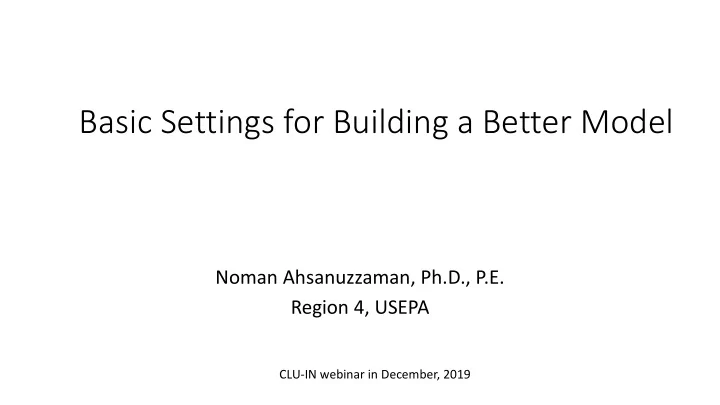

Basic Settings for Building a Better Model Noman Ahsanuzzaman, Ph.D., P.E. Region 4, USEPA CLU-IN webinar in December, 2019
Outline • Important issues for setting up a groundwater model • Basic checks for a flow and transport model • Uncertainty analysis • A modeling framework may be useful
Before Modeling • CSM (conceptual site model) • Plan view (DEM) of the model domain • X-section (lithology) • Physical and Hydrogeologic conditions (e.g., porous system or fractured rock) • Modeling objectives • Data availability/Data gaps? • Is modeling necessary to get an answer for decision making?
Initial Preparation for Groundwater Modeling • What datasets represent the best steady-state flow condition? • Separate datasets for calibration and validation • Are there any datasets for transient flow calibration? • Identify the Target wells • Is the source mass/concentration decaying? • What is a reasonable estimate for partitioning coefficient (i.e., retardation factor) • Is biodegradation happening? Do you degradation products? Any approximation of the biodegradation rate? • Is the selected modeling package robust enough to handle the geochemical processes?
Model Setup
Flow Model Calibration • More data is available for flow model calibration • Transport model depends on the flow model • Manual vs. Automated (PEST) calibration? • PEST is inverse modeling tool for automated calibration of model parameters. • PEST is popular among modelers/consultants • Pilot Points in PEST should be limited in numbers and have a tight range for each parameter • Initial values are sensitive in PEST calibration • Start with manual calibration and then improve with PEST – Rarely/Never followed in practice !! Calibrated hydraulic conductivity of surficial aquifer
Flow Model Calibration (contd.) • Calibration criteria in industry is NRMSE <= 10% • NRMSE (Normalized Root Mean Square of Error) • NRMSE = RMSE/(Range of Observed Head) ×100% • Goal should be NRMSE≈5% in the key areas/layers • Group target wells for calibration in the key areas • Try to achieve NRMSE≈5% in the key areas • Do not just check site-wide NRMSE <=10% • Also qualitatively match observed vs. calibrated potentiometric surface maps. Calibrated hydraulic conductivity of surficial aquifer
Calibration/Validation • Residual Distribution Map • Residual Error should be well distributed • Avoid bias to minimize error in hydraulic gradient • Validation should be done with a dataset not used in calibration • Calibration-Validation is an iterative process Calibration Validation • Validation is not popular among consultants!
Sensitivity/Uncertainty Analysis • Parameter sensitivity is most commonly done in practice • Again, not so popular among consultants! • Common practice is to compare the RMSE values between simulated and the calibrated models . • Doesn’t help in decision making, since it doesn’t address sensitivity to the model objectives. For example , • Capture zones in a pump & treat system • Time to reach the cleanup goal • We expect to see model uncertainty as it relates to the modeling objectives and identify data gaps to address that uncertainty.
Solute Transport Model • Three common questionable practices • Retardation Factor (RF) is too high! • Source is instantaneous/initial? • Biodegradation Rate (half-life) calibration? • RF could be estimated in the following ways, 1. Find the partitioning coefficient (K d ) from batch or column test 2. Measure fraction of organic carbon (f OC ) from the site soil and use literature to get K OC for each COC. ( most commonly done ) 3. Calibrate in the solute transport model • Batch test will usually generate high values of K d (i.e., high RF), • f OC from the contaminated subsurface soil sample will be very high and thus result in high RF ( very common mistake ). Need to test on background samples. • Initial estimation from column test of undisturbed soil sample followed by model calibration is likely the best option (time consuming and costly) • Calibration of RF has high uncertainty, because of too many sensitive model parameters. • Particle tracking modeling shows groundwater flow direction (Need a good flow model).
Solute Transport/ Instantaneous Source • Initial concentration of the plume is assigned, but no continuous source!? • Plume in the source area will deplete quickly unless the K d is very high (Figure) • Artificially high K d is sometime used to model back diffusion. (questionable practice!) • Historic matching of the source concentration must be done to define the source boundary in the model. EW-1 EW-2 Average Minimum Maximum 11 Average Minimum Maximum
Solute Transport/ Biodegradation Rate • Do a well-by-well trend analysis and estimate the decay rate (k). • Biodegradation rate (ϒ) is NOT k. (Ideally, ϒ<<k) • Look for daughter products to confirm biodegradation is happening! • Biodegradation rate is usually not uniform throughout the site. 0 Yrs 50 Yrs Half-Life = 13 yrs (from calibration); i.e., 1 order of magnitude concentration decrease in about 40 yrs. 12
Solution? • Get involved early, not after the consultant has completed his calibration and used up all the funding ( often the case ). • Make sure to discuss the modeling framework and workplan in the beginning? • Specific modeling guideline is not available (to my knowledge). • Modeling world is vast and it’s hard to cover every aspect through a guideline • Wanted to highlight some common issues rather than trying to cover the broad spectrum in the modeling world! • A simple modeling framework/checklist might be needed!
Thank You Question and Comments
Recommend
More recommend